Live Cell Imaging Market Size
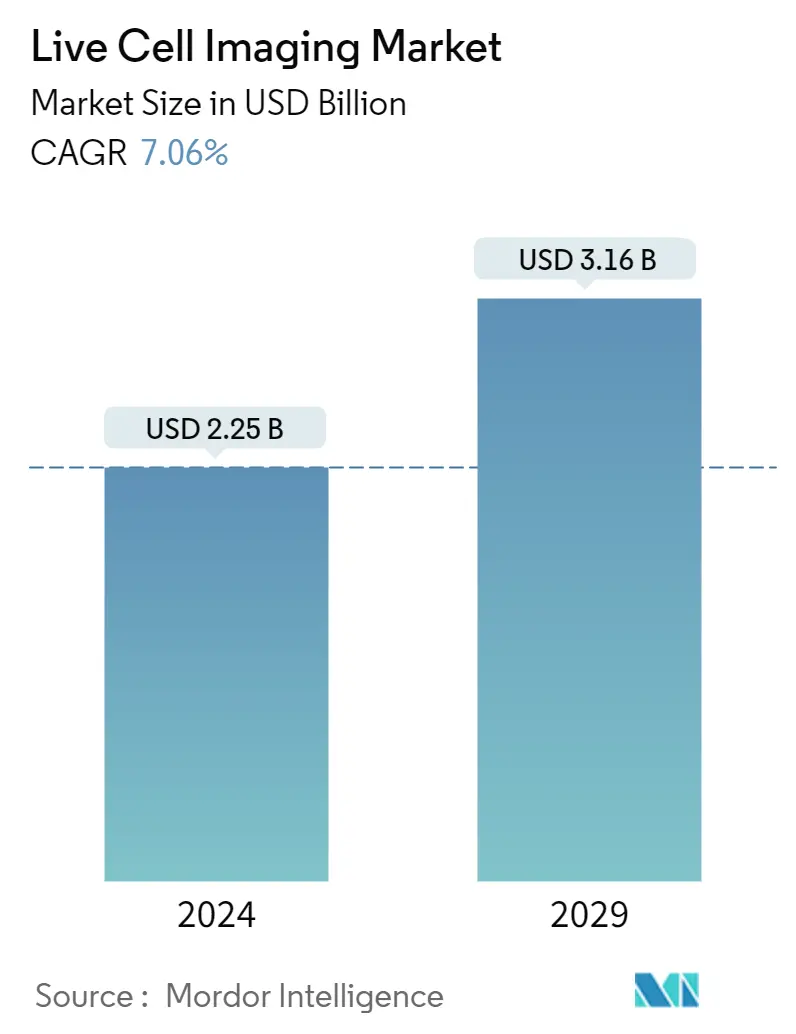
| Study Period | 2019 - 2029 |
| Market Size (2024) | USD 2.25 Billion |
| Market Size (2029) | USD 3.16 Billion |
| CAGR (2024 - 2029) | 7.06 % |
| Fastest Growing Market | Asia-Pacific |
| Largest Market | North America |
Major Players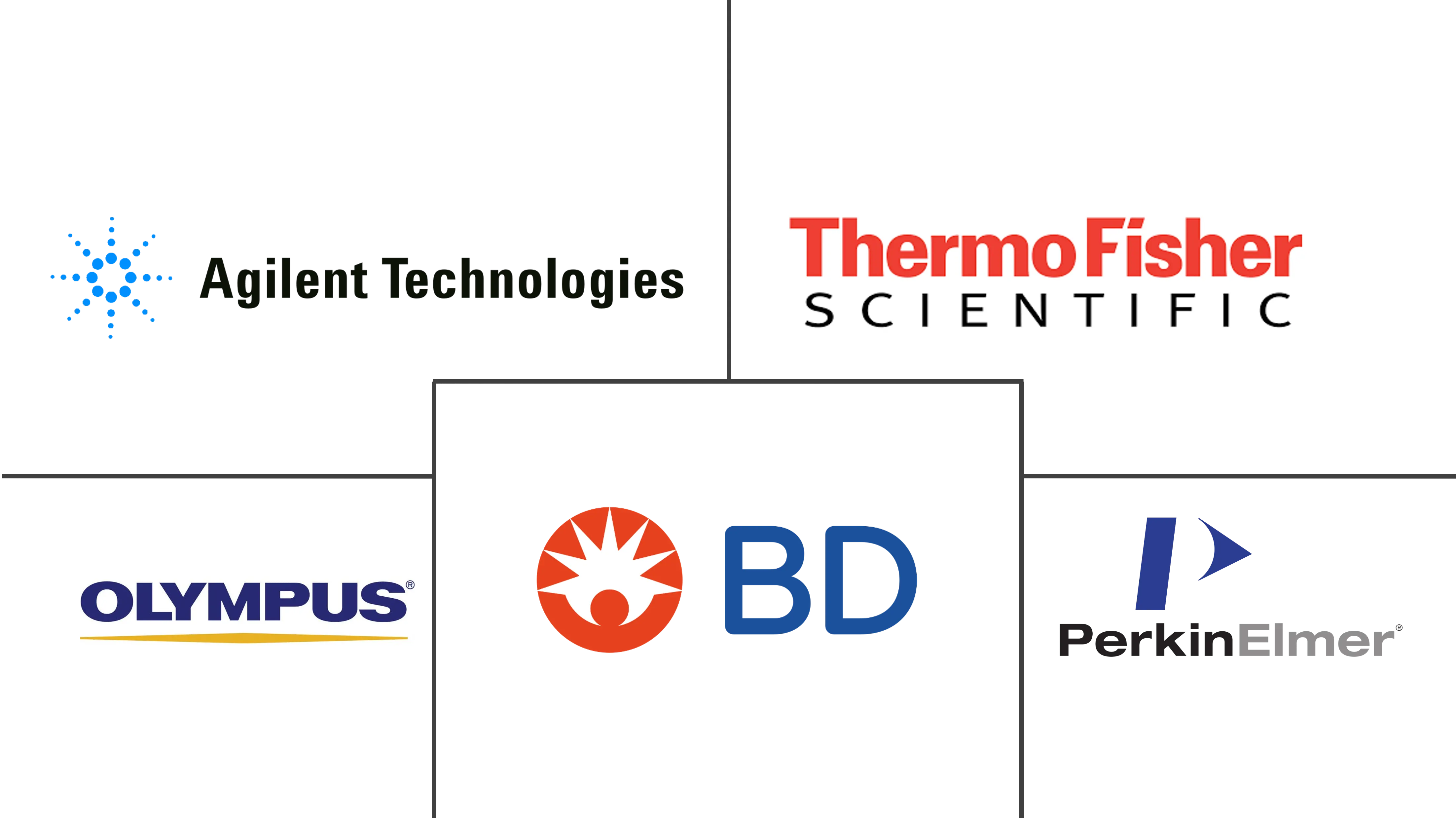
*Disclaimer: Major Players sorted in no particular order |
Live Cell Imaging Market Analysis
The Live Cell Imaging Market size is estimated at USD 2.25 billion in 2024, and is expected to reach USD 3.16 billion by 2029, growing at a CAGR of 7.06% during the forecast period (2024-2029).
The COVID-19 pandemic had a severe impact on the market as there were supply chain disruptions due to the lockdown. However, the increasing demand for the early diagnosis of COVID-19 infection in order to develop an effective vaccination propelled the growth of the market as it led to increasing usage of the live cell imaging process. According to a research study published in Antiviral Research Journal in November 2021, a live-cell-based test for assessing the intracellular function of the CoV2 target, the Main 3C-like protease, was created, which is important and highly conserved (Mpro) and this method provided a high-throughput COVID-19 Main Protease (Mpro) screening system. The rising application of live-cell imaging in the identification of intracellular functions in COVID-19 led to increased adoption of live cell imaging and considerably impacted the market studied during the pandemic. Therefore, the increasing usage of live cell imaging equipment for the study of the molecular biology of the COVID-19 virus is expected to drive the growth of the market over the forecast period.
The growth of the live cell imaging market is attributed to the adoption of high-content screening techniques in drug discovery, the rising prevalence of chronic disease demanding higher and quicker diagnostic facilities, and government funding for cell-based research.
Live-cell imaging is a detection mode for cell-based assays and high-content screening techniques in drug discovery that helps in the identification of multiple measures of cell physiology, whether from sub-cellular compartments, multicellular structures, or model organisms. According to a study published in Frontiers in Cell and Developmental Biology in January 2021, high-content screening has aided in the comprehension of varied downstream effects for multiple treatments on cancer cells, specifically organelle targets, estimating the overall cellular response efficiently for new candidate molecules, and evaluating signaling heterogeneity. The rising advantages of high-content screening in understanding cancer cell response to novel drugs are expected to drive the adoption of the devices used for live cell imaging for the development of novel cancer treatments and fuel the overall market growth.
Besides, the development of innovative products is also contributing to market growth. For instance, in June 2021, Leica Microsystems launched the Leica Nano workflow, a new live-cell correlative light, and electron microscopy (CLEM) workflow solution designed to increase experimental success rates, improve reproducibility, and simplify light and electron microscopy (EM) integration. In addition, in January 2021, Zeiss Group launched the ZEISS Visioner 1, an innovative digital microscope for live-cell imaging that facilitates all-in-one focus in real-time through its Micro-mirror Array Lens System (MALS). This initiative is aimed at simplifying the imaging process and delivering higher throughput. Therefore, these developments in the market are predicted to garner the market's growth over the forecast period.
However, factors such as the high cost of high-content screening systems and the shortage of skilled professionals may hinder the growth of the market.
Live Cell Imaging Market Trends
Standalone Systems Segment is Expected to Hold a Significant Market Share Over the Forecast Period
Standalone systems are referred to as equipment or devices that are able to function independently of other hardware and are not integrated into another device. The major factors fueling the growth of the segment are the significant use of these systems in live-cell imaging and the increasing focus on research and development (R&D) with the use of technology. For instance, as per the Journal of Cell Biology published in May 2023, StableMARK (Stable Microtubule-Associated Rigor-Kinesin), a live-cell marker to visualize stable microtubules, enabled the exploration of different microtubule subsets throughout the cell cycle to understand the contribution to cellular organization and transport. Therefore, due to the emergence of advanced and innovative standalone systems in the market, this segment is expected to grow over the forecast period.
Additionally, in February 2022, TGen and Deepcell collaborated to employ artificial intelligence-based technology to classify and isolate diseased cells. Deepcell provides AI-powered technology that transforms cell morphology into a quantitative and high throughput marker for use in research to complement existing molecular workflows as well as a novel standalone method. Such collaborations in research are anticipated to fuel the development of standalone systems for live-cell imaging, thereby contributing to market growth.
Moreover, well-established market players also offer standalone systems for live-cell imaging, thereby contributing to the growth of the segment. For instance, Becton Dickinson and Company offers BD Pathway 855 Stand-Alone System, which offers the ultimate flexibility for high-content imaging of live and fixed cells. Hence, due to the availability of innovative products in the segment, the competition is rising, and it is anticipated to drive the segment growth over the forecast period.
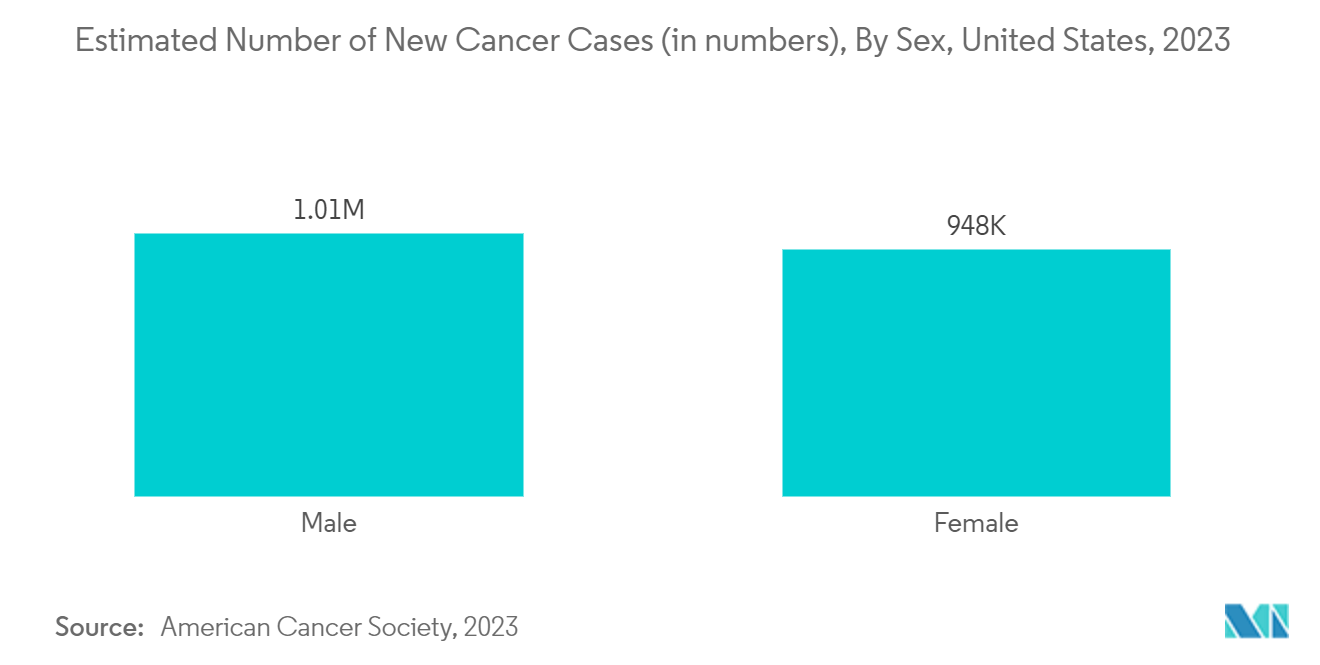
North America is Expected to Hold a Significant Share of the Market During the Forecast Period
North America holds a significant share of the live cell imaging market and is expected to continue its growth trend during the forecast period. The major factors attributed to the market growth in the region are the presence of a larger patient pool and an increasing geriatric population.
The increasing investment and funding available for research in live-cell imaging is the key driver in this region. In North America, the United States holds a prominent market share due to factors, such as the burden of chronic diseases, along with a growing number of R&D programs in the country. For instance, according to the Cancer Facts and Figures 2023 report by the American Cancer Society, an estimated 1.9 million new cancer cases are expected to be diagnosed in the United States in 2023, among which nearly 1010,310 cases will be men and 948,000 cases will be women. The high number of people getting affected by cancer is expected to increase the demand for the diagnosis of cancer and is expected to boost the market's growth in the region.
Additionally, the presence of major market players and key strategies implemented by them, such as partnerships and collaborations also expected to contribute to the growth of the live cell imaging market in North America. For instance, in March 2022, Axion BioSystems, one of the major life sciences tools companies focused on advanced live-cell assay systems, reported the acquisition of CytoSMART Technologies, an innovator in kinetic live-cell imaging analysis. This will lead to increased adoption of cell imaging devices in the United States, thereby driving the overall market growth in the region.
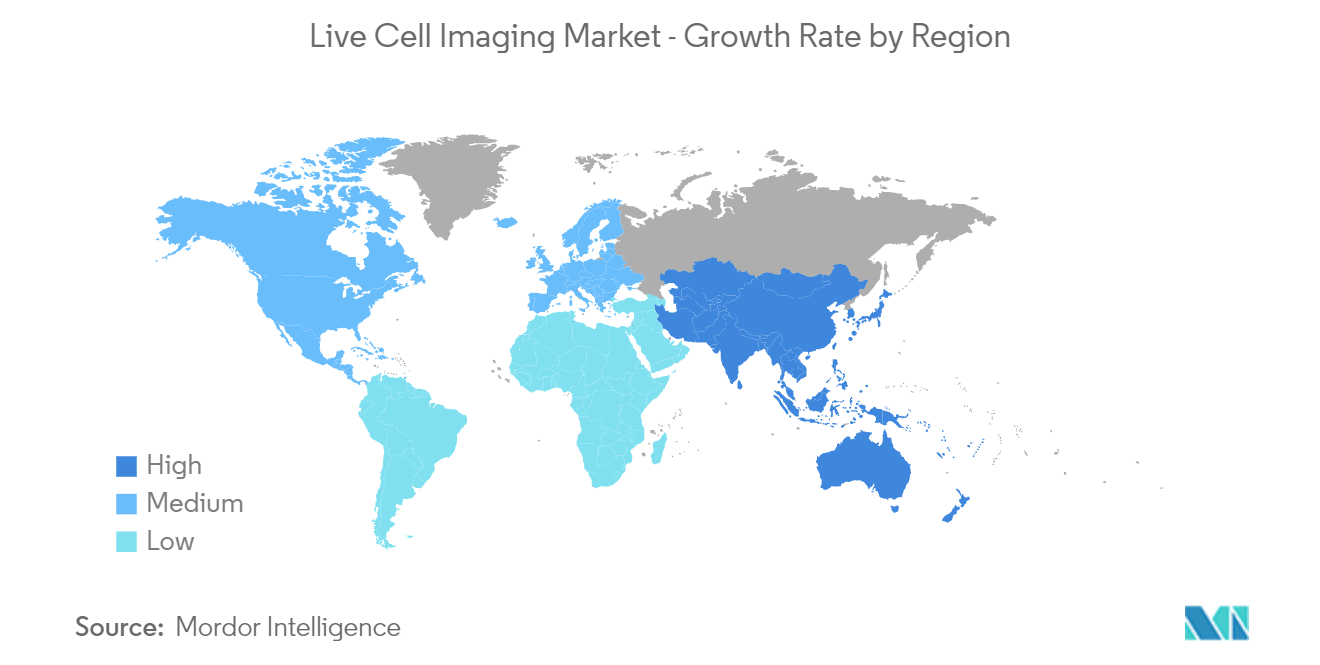
Live Cell Imaging Industry Overview
The live cell imaging market is competitive with several players. The companies are implementing certain strategic initiatives, such as mergers, new product launches, acquisitions, and partnerships, that help them strengthen their market positions. Some companies currently dominating the market are Becton, Dickinson and Company, Zeiss Group, Danaher Corporation, Olympus Corporation, Live Cell Instrument, Nikon Corporation Inc., Perkin Elmer Inc., Merck KGaA, Thermo Fisher Scientific Inc., and others.
Live Cell Imaging Market Leaders
-
PerkinElmer Inc
-
Becton, Dickinson and Company
-
Thermo Fisher Scientific Inc.
-
Agilent Technologies. Inc.
-
Olympus Corporation (Evident)
*Disclaimer: Major Players sorted in no particular order
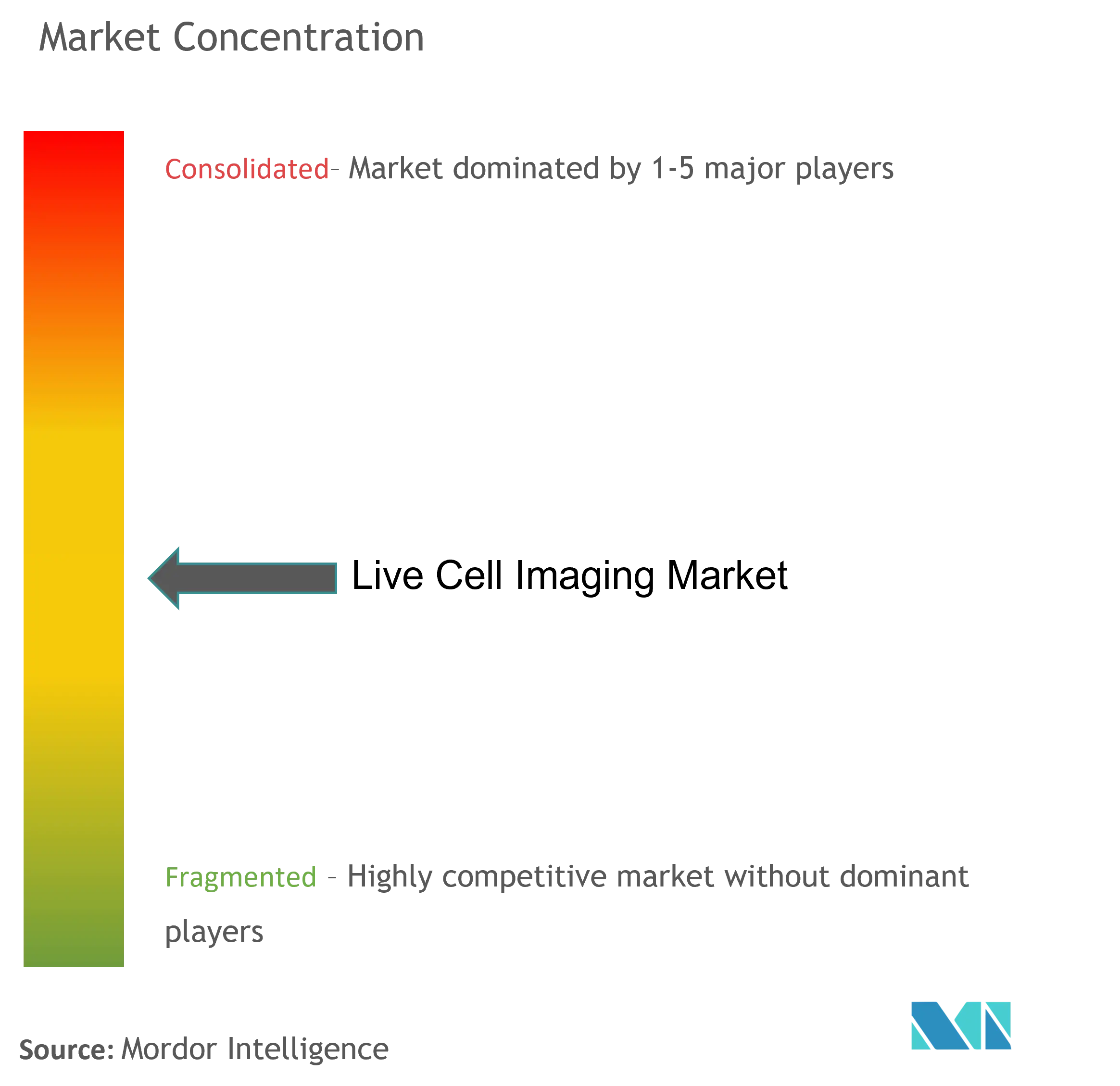
Live Cell Imaging Market News
- June 2023: Nanolive launched the 3D Cell Explorer 96focus, an innovative platform that brings unlimited high content analysis to label-free live cell imaging without the need for labeling. With the aid of AI-powered digital assays and an automated workflow, the 3D Cell Explorer 96focus streamlines the imaging process, offering researchers a cost-effective and reliable means of conducting cell imaging experiments.
- February 2023: Nikon Corporation launched the Nikon Spatial Array Confocal (NSPARC) detector for AX systems. This detector enables high-resolution imaging of live tissue with minimal phototoxicity.
Live Cell Imaging Market Report - Table of Contents
1. INTRODUCTION
- 1.1 Study Assumptions and Market Definition
- 1.2 Scope of the Study
2. RESEARCH METHODOLOGY
3. EXECUTIVE SUMMARY
4. MARKET DYNAMICS
- 4.1 Market Overview
-
4.2 Market Drivers
- 4.2.1 Adoption of High-content Screening Techniques in Drug Discovery
- 4.2.2 Rising Prevalence of Chronic Disease Demanding Higher and Quicker Diagnostic Facilities
- 4.2.3 Government Funding for Cell-based Research
-
4.3 Market Restraints
- 4.3.1 High Cost of High-content Screening Systems
- 4.3.2 Shortage of Skilled Professionals
-
4.4 Porter's Five Forces Analysis
- 4.4.1 Bargaining Power of Suppliers
- 4.4.2 Bargaining Power of Buyers
- 4.4.3 Threat of New Entrants
- 4.4.4 Threat of Substitute Products/Services
- 4.4.5 Intensity of Competitive Rivalry
5. MARKET SEGMENTATION (Market Size by Value - USD million)
-
5.1 By Product
- 5.1.1 Equipment
- 5.1.1.1 Standalone Systems
- 5.1.1.2 Microscopes
- 5.1.1.3 Cell Analyzers
- 5.1.1.4 Image Capturing Devices
- 5.1.2 Consumables
- 5.1.2.1 Reagents and Kits
- 5.1.2.2 Other Consumables
- 5.1.3 Software and Services
-
5.2 By Application
- 5.2.1 Cell Biology
- 5.2.2 Developmental Biology
- 5.2.3 Stem Cell Biology
- 5.2.4 Drug Discovery
- 5.2.5 Other Applications
-
5.3 Geography
- 5.3.1 North America
- 5.3.1.1 United States
- 5.3.1.2 Canada
- 5.3.1.3 Mexico
- 5.3.2 Europe
- 5.3.2.1 Germany
- 5.3.2.2 United Kingdom
- 5.3.2.3 France
- 5.3.2.4 Italy
- 5.3.2.5 Spain
- 5.3.2.6 Rest of Europe
- 5.3.3 Asia-Pacific
- 5.3.3.1 China
- 5.3.3.2 Japan
- 5.3.3.3 India
- 5.3.3.4 Australia
- 5.3.3.5 South Korea
- 5.3.3.6 Rest of Asia-Pacific
- 5.3.4 Middle East and Africa
- 5.3.4.1 GCC
- 5.3.4.2 South Africa
- 5.3.4.3 Rest of Middle East and Africa
- 5.3.5 South America
- 5.3.5.1 Brazil
- 5.3.5.2 Argentina
- 5.3.5.3 Rest of South America
6. COMPETITIVE LANDSCAPE
-
6.1 Company Profiles
- 6.1.1 Becton, Dickinson and Company
- 6.1.2 Zeiss Group
- 6.1.3 Axion BioSystems, Inc
- 6.1.4 Danaher (Leica Microsystems)
- 6.1.5 Olympus Corporation (EVIDENT)
- 6.1.6 LCI (Live Cell Instrument)
- 6.1.7 Nikon Corporation Inc
- 6.1.8 PerkinElmer Inc.
- 6.1.9 Merck KGaA (Sigma- Aldrich Corporation)
- 6.1.10 Thermo Fisher Scientific Inc.
- 6.1.11 Agilent Technologies. Inc.
- 6.1.12 Sartorius AG
- *List Not Exhaustive
7. MARKET OPPORTUNITIES AND FUTURE TRENDS
** Subject To AvailablityLive Cell Imaging Industry Segmentation
As per the scope of this report, live-cell imaging techniques allow the real-time examination of every aspect of cellular function under normal and experimental examinations. The Live Cell Imaging Market is Segmented by Product (Equipment, (Standalone Systems, Microscopes, Cell Analyzers, and Image Capturing Devices), Consumables (Reagents and Kits and Other Consumables), and Software and Services), Application (Cell Biology, Developmental Biology, Stem Cell Biology, Drug Discovery, and Other Applications), and Geography (North America, Europe, Asia-Pacific, Middle East and Africa, and South America). The market report also covers the estimated market sizes and trends of 17 countries across major regions globally. The report offers the market size in value terms in USD for all the abovementioned segments.
| By Product | Equipment | Standalone Systems |
| Microscopes | ||
| Cell Analyzers | ||
| Image Capturing Devices | ||
| By Product | Consumables | Reagents and Kits |
| Other Consumables | ||
| By Product | Software and Services | |
| By Application | Cell Biology | |
| Developmental Biology | ||
| Stem Cell Biology | ||
| Drug Discovery | ||
| Other Applications | ||
| Geography | North America | United States |
| Canada | ||
| Mexico | ||
| Geography | Europe | Germany |
| United Kingdom | ||
| France | ||
| Italy | ||
| Spain | ||
| Rest of Europe | ||
| Geography | Asia-Pacific | China |
| Japan | ||
| India | ||
| Australia | ||
| South Korea | ||
| Rest of Asia-Pacific | ||
| Geography | Middle East and Africa | GCC |
| South Africa | ||
| Rest of Middle East and Africa | ||
| Geography | South America | Brazil |
| Argentina | ||
| Rest of South America |
Live Cell Imaging Market Research FAQs
How big is the Live Cell Imaging Market?
The Live Cell Imaging Market size is expected to reach USD 2.25 billion in 2024 and grow at a CAGR of 7.06% to reach USD 3.16 billion by 2029.
What is the current Live Cell Imaging Market size?
In 2024, the Live Cell Imaging Market size is expected to reach USD 2.25 billion.
Who are the key players in Live Cell Imaging Market?
PerkinElmer Inc, Becton, Dickinson and Company, Thermo Fisher Scientific Inc., Agilent Technologies. Inc. and Olympus Corporation (Evident) are the major companies operating in the Live Cell Imaging Market.
Which is the fastest growing region in Live Cell Imaging Market?
Asia-Pacific is estimated to grow at the highest CAGR over the forecast period (2024-2029).
Which region has the biggest share in Live Cell Imaging Market?
In 2024, the North America accounts for the largest market share in Live Cell Imaging Market.
What years does this Live Cell Imaging Market cover, and what was the market size in 2023?
In 2023, the Live Cell Imaging Market size was estimated at USD 2.10 billion. The report covers the Live Cell Imaging Market historical market size for years: 2019, 2020, 2021, 2022 and 2023. The report also forecasts the Live Cell Imaging Market size for years: 2024, 2025, 2026, 2027, 2028 and 2029.
Live Cell Imaging Industry Report
Statistics for the 2023 Live Cell Imaging market share, size and revenue growth rate, created by Mordor Intelligence™ Industry Reports. Live Cell Imaging analysis includes a market forecast outlook to 2029 and historical overview. Get a sample of this industry analysis as a free report PDF download.



